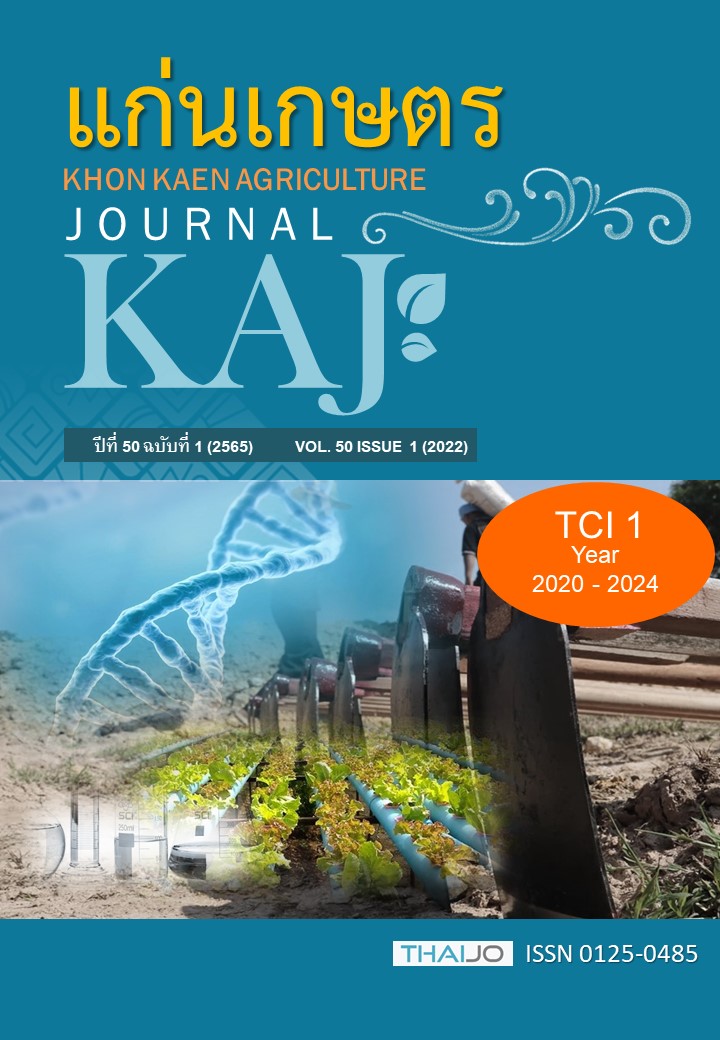Quinone outside inhibitor fungicides combine with salicylhydroxamic acid to inhibit leaf spotting fungi from hydroponic lettuce for sensitivity in vitro test
Main Article Content
บทคัดย่อ
Hydroponics is a popular alternative to conventional growing approaches in Thailand, and many farmers use this method, especially to grow lettuce. Several different types are common: green oak, red oak, butterhead, red coral, and frillice iceberg. However, outdoor hydroponics in tropical zone presents a problem for farmers due to the fungal disease known as leaf spot. Prevent treatments used for leaf spots include a class of fungicides categorized as quinone outside inhibitor (QoI) fungicides. The principal types are trifloxystrobin (TF), azoxystrobin (AZ), and pyraclostrobin (PR). This study visited commercial hydroponics operations and took 17 fungal pathogen isolates from lettuce plants exhibiting leaf spot disease. Among these isolates, there were 9, 5, 2, and 1 isolates of Cercospora sp., Corynespora cassiicola, Curvularia sp., and Alternaria sp., respectively. The inhibition of mycelial respiration on potato dextrose agar (PDA) as a consequence of the combined effect of TF, AZ, and PR with salicylhydroxamic acid (SHAM) were evaluated with the classification of the levels of sensitivity based on 50% effective concentrations (EC50). The SHAM reaction demonstrated synergism in each of the tested fungicides with a synergy factor greater than 1. In the case of the two isolates of C. cassiicola, a high degree of resistance (HR) was reported with the isolated code as RO_PT012 to TR, AZ, and PY, and isolate RO_PT013 to AZ and TR, with an EC50 value above 100 mg/l. Furthermore, a majority of the fungal isolates were categorized as sensitive (S) to the QoI fungicides tested, having EC50 values lower than 10 mg/l. Therefore, it was concluded that SHAM showed a synergistic effect with the QoI fungicide, which was significant while assessing the level of QoI sensitivity under in vitro testing.
Article Details

อนุญาตภายใต้เงื่อนไข Creative Commons Attribution-NonCommercial-NoDerivatives 4.0 International License.
เอกสารอ้างอิง
Asim, M., Y. Iftikhar, M. Arshad, S. Bashir, M. Raza, and S. Bilal. 2019. Inhibitory effect of various fungicides on mycelial growth of Alternaria alternata; cause of Alternaria leaf spot disease on Rosa Indica L. in Pakistan. Asian Journal of Agriculture Biology. 7(3): 474-481.
Bradley, C. A., and D. K. Pedersen. 2011. Baseline sensitivity of Cercospora zeae-maydis to quinone outside inhibitor fungicides. Plant Disease. 95(2): 189-194.
Chairin, T., C. Pornsuriya, N. Thaochan, and A. Sunpapao. 2017. Corynespora cassaiicola causes leaf spot disease on lettuce (Lactuca sativa) cultivated in hydroponic systems in Thailand. Australasian Plant Disease Notes. 12(1): 14-16.
Corio-Costet, M. F., M.C. Dufour, J. Cigna, P. Abadie, and W.J. Che. 2011. Diversity and fitness of Plasmopara viticola isolates resistant to QoI fungicides. European journal of plant pathology. 129: 315–329.
Fernández-Ortuño, D., J.A. Torés, A. Vicente, and A. Pérez-García. 2008. Mechanisms of resistance to QoI fungicides in phytopathogenic fungi. International Microbiology. 11: 1-9.
Gisi, U., H. Sierotzki, A. Cook, and A. McCaffery. 2002. Mechanisms influencing the evolution of resistance to Qo inhibitor fungicides. Pest Management Science. 58(9): 859–867.
Jin, L. H., Y. Chen, C. J. Chen, J. X. Wang, and M. G. Zhou. 2009. Activity of azoxystrobin and SHAM to four phytopathogens. Agricultural Sciences in China. 8(7): 835–842.
Kongtragoul, P., K. Imamoto, and H. Ishii. 2020. Resistance to quinone-outside inhibitor (QoI) fungicides in Colletotrichum species isolated from anthracnose disease occurring in Thailand. Current Applied Science and Technology. 20(1): 79-89.
Kongtragoul, P., S. Nalumpang, Y. Miyamoto, Y. Izumi, and K. Akimitsu. 2011. Mutation at codon 198 of Tub2 gene for carbendazim resistance in Colletotrichum gloeosporioides causing mango anthracnose in Thailand. Journal of Plant Protection Research. 51(4): 377-384.
Koohakan, P., T. Jeanaksorn, and I. Nuntagij. 2008. Major diseases of lettuce grown by commercial nutrient film technique in Thailand. Current Applied Science and Technology. 8(2): 56-63.
Li, L., and Y. Zou. 2017. Induction of disease resistance by salicylic acid and calcium ion against Botrytis cinerea in tomato (Lycopersicon esculentum). Emirates Journal of Food and Agriculture. 29(1): 78-82.
O'Neill, T. 2019. Diseases of lettuce crops. 1th Edition. Agriculture and Horticulture Development Board Horticulture Stoneleigh Park Kenilworth Warwickshire, UK.
Seyran, M., T. B. Brenneman, and K. L. Stevenson. 2010. In vitro toxicity of alternative oxidase inhibitors salicylhydroxamic acid and propyl gallate on Fusicladium effusum. Journal of Pest Science. 83: 421–427.
Sierotzki, H., J. Wullschleger and U. Gisi. 2000. Point Mutation in Cytochrome b Gene Conferring Resistance to Strobilurin Fungicides in Erysiphe graminis f. sp. tritici Field Isolates. Pesticide Biochemistry and Physiology. 68: 107-112.
Teramoto, A., M. C. Meyer, N. D. Suassuna, and M. G. Cunha. 2017. In vitro sensitivity of Corynespora cassiicola isolated from soybean to fungicides and field chemical control of target spot. Summa Phytopathologica. 43(4): 281–289.
Torres-Calzada, C., R. Tapia-Tussell, I. Higuera-Ciapara, R. Martin-Mex, A. Nexticapan-Garcez, and D. Perez-Brito. 2015. Sensitivity of Colletotrichum truncatum to four fungicides and molecular characterization of thiabendazole-resistant isolates. Plant Disease. 99: 1590-1595.
Vaghefi, N., F.S. Hay, J. R. Kikkert, and S. J. Pethybridge. 2016. Genotypic diversity and resistance to azoxystrobin of Cercospora beticola on processing table beet in New York. Plant Disease. 100(7): 1466–1473.
Wattanapreechanon, E., and P. Sukprasert. 2012. Development of soilless culture for crop production in Thailand. Kasetsart Journal of Social Sciences. 33(3): 475-485.
Wattanapreechanon, E., and P. Sukprasert. 2016. Hydroponic vegetable cultivation development for extension at Luk Phra Dabos Agricultural Training and Development Center, Samut Prakan province. RMUTSB Academic Journal. 4(2): 106-119.
Zhang, C., Y. Liu, L. Ding, and G. Zhu. 2011. Shift of sensitivity of Botrytis cinerea to azoxystrobin in greenhouse vegetables before and after exposure to the fungicide. Phytoparasitica. 39: 293–302.


